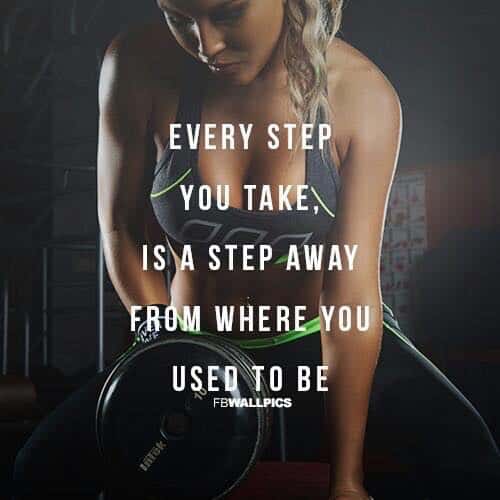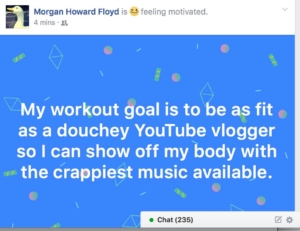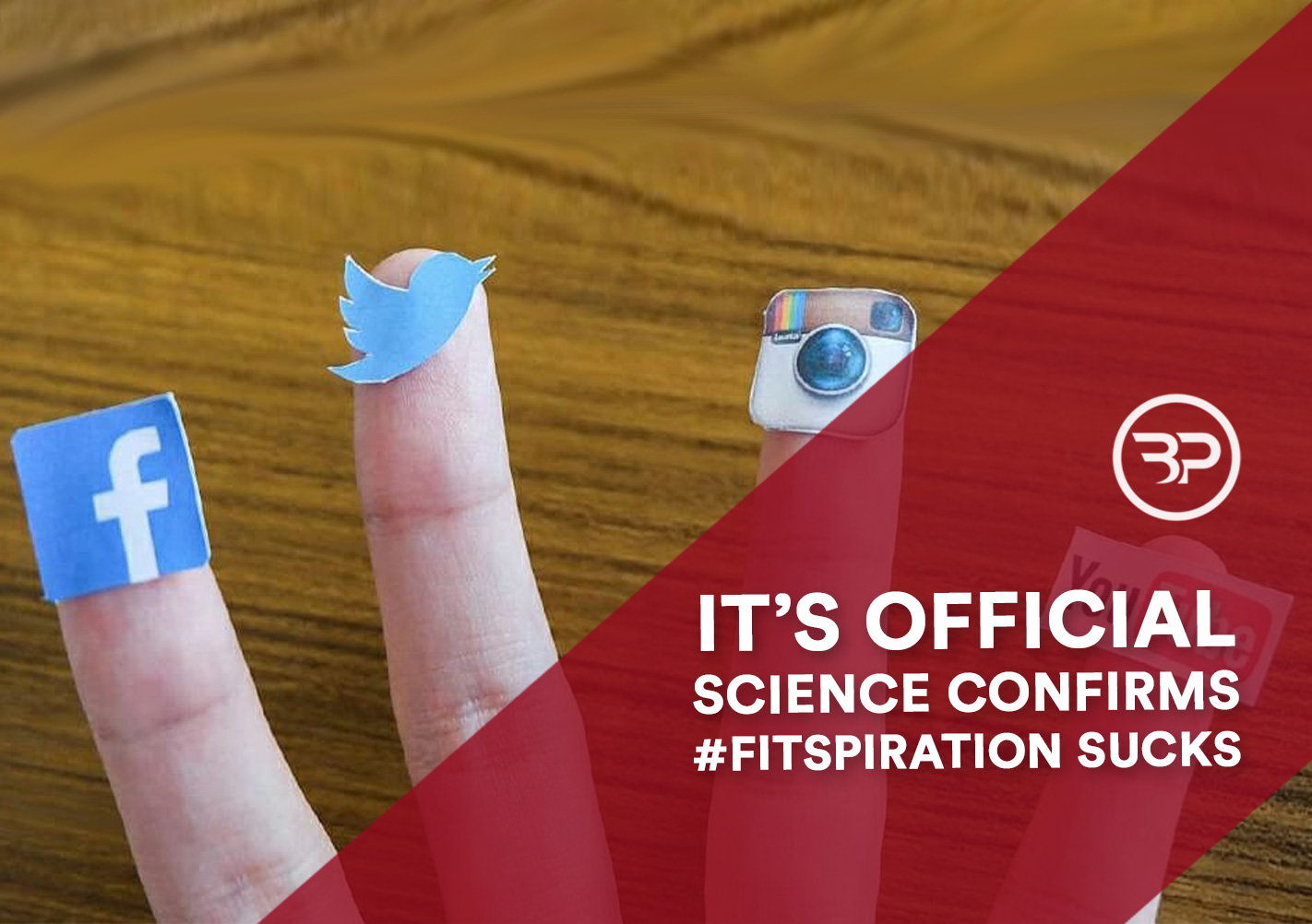It’s Official: Science Confirms #Fitspiration Sucks
September 12, 2017
Guest Post By Lee Bell
Heaping contempt and ridicule on “instagram trainers” is easy — and fully justified. Now science confirms it. Keep reading to find out why.
Sometimes it seems like the only things you need to succeed in the fitness biz these days is a big pair of biceps (or boobs), good looks, and a slick but cynical social media strategy.
How about actually knowing something about fitness — and how to help others? Increasingly, it seems to be optional. Maybe even irrelevant. As a certain politician might tweet: #Sad!
Why? Well, fitness doesn’t exist in a vacuum. As people scroll through their social media feeds on fast forward on the lookout for a cute cat flushing a toilet, an image stops them in their tracks. They slam on the brakes to take a better look.
Guess what it shows? Yup, It’s a sexy fitness model, complete with a motivational quote.
Welcome to….
…The Concept of “Fitspiration”
Like a social revelation, Fitspiration has hit us with so much force that you could so easily mistake it for a full-on Tyson body shot combo. With so few people achieving the recommended amount of physical exercise, we definitely need a push in the right direction.

Maybe that’s where Fitspiration comes in? Are motivational messages and adonis-like imagery the way forward when it comes to getting us in the gym? Or is there a more sinister side to this popular social tool?
What is Fitspiration?
Fitspiration is short for fitness inspiration. Any message that is meant to inspire you to boost your fitness and encourage you to achieve your fitness goals is fitspiration.
More often than not, you’ll find these type of messages laid out as easy to digest, motivational quotes. A semi-related picture of a man or woman is attached. But it ain’t no selfie. These images are usually high definition, professionally filtered photographs of tanned, toned and muscular models.
You’ll find fitspiration under the hashtags #fitspiration, #fitspo and many other variations.
What are these images meant to achieve?
The bottom line is that fitspiration images are meant to motivate you. They are meant to improve your mindset, help you chase your goals, push you to seize the day, blah-blah-blah. They are meant to be gentle reminders that you could make some positive changes today and improve your diet, fitness, and lifestyle for tomorrow.
In short, fitspiration is “an online trend designed to inspire viewers towards a healthier lifestyle by promoting exercise and healthy food” [1].
What Does a #fitspiration Search Bring Up on Your Screen?
These were the first three that turned up in a recent search.
“You are either on my side, by my side, or in my fucking way. Choose wisely”
- This came complete with a black and white picture of a woman in a black sports bra… and lifting gloves… and sculpted abs. She’s looking down at the floor in a manner that shows she’s deep in thought.
“Fear no workout, destroy every rep, feel every rep”
- The accompanying image? A dark-filtered picture of a shirtless man standing over a barbell. He’s got chalk all over his hands and lifting straps and looks ready for a big lift.
“It’s not about having time. It’s about making time”.
- The image? A lady in tight leggings and a vest top on all fours in her front room. She’s doing a single arm row and looking like she’s ‘in the zone’.
The common traits you’ll find are short, soundbite-like quotes. Positive, glossy imagery. A “you can do this”’ vibe. They are all different, yet all very similar in both messages and feel. Some of these images have an underlying message of guilt behind them: a “‘what’s your excuse?”’ kind of theme.
Millions of these types of images uploaded to various social outlets each day. There is little variation.
What The Really Science Really Says
And as scientific research catches up with this social media boom, we’re now seeing an influx of research studies focusing on the actual effects of regular exposure to such content.
In fact, this recent research has found a bit of a trend with fitspiration imagery.
A 2017 article published in the Journal of Medical Internet Research [2] analysed content tagged with the popular #fitspo hashtag over a 30-minute time period. They included anything using the tag across various social outlets and included a total of over 400 images.
From their analysis, the authors found that:
- 74.2% of the images were related to exercise and 19.6% were related to food.
- Over a third of posts depicted females, with males accounting for just over 25%.
- Females typically appeared to be thin but toned or athletic. Males often appeared to be muscular or have bodybuilder-like physiques.
The most interesting trend though? There was a definite gender bias towards showing different body parts.
“She squats”…. Just look at her ass!

The study found that when women appeared in fitspiration images, they were much more likely to show off their full bodies, in particular their asses.
They were also more likely to be aged 25 or under and be highly sexualized, with minimal clothing (definitely not the sort you’d see in an actual gym). Males, on the other hand, were more likely to have their faces on the posts and were less sexualized.
From Arnold to, Well…Everyone
Back when I was growing up, there was no social media. My fitspiration came from being in the gym, watching the bigger guys, buying Flex magazine or watching Pumping Iron. in fact, I was such a fan of Arnold that his world famous chest, arms and abs graced my bedroom walls for most of my teens.
I don’t think there was a square foot of my box room that wasn’t covered in a black and white A1 of the Austrian oak. But it wasn’t a fitspiration overload by any stretch.
Each morning I’d look at the pictures on my wall and that was enough motivation. All I wanted was to look like Arnold. And that was pretty much all the inspiration I was subjected to each day… or needed. This was a guy that was a world champion. And his physique was goddamn motivating.
But now there’s fitspiration from practically everyone – all day, every day. The boom in media outlets has made it possible for anyone to share their own fitspirations messages,- regardless of whether they are a former Mr, Olympia, a professional athlete, or a sponsored fitness model for some obscure supplement brand (slight dig was intentional).

Basically, everyone wants their body to inspire others. In other words, fitspiration isn’t just reserved for the truly inspiring. It’s reserved for anyone who wishes to be motivating.
Does Fitspiration Lead to Unattainable Goals?
One concern with fitspiration images is that repeated representation of only one particular body type can lead to many people striving for physiques that are just not attainable.
They think that looking a certain way is the main driver of exercise, not feeling healthier or reducing the risk of long-term disease.
It’s a kind of ‘I see this type of body all day on social media. This must be what’s beautiful so I’m going to work my ass off to look like that’ mentality.
And with the quotes I found this morning, such as “Fear no workout, destroy every rep, feel every rep” it also hints that every workout, every session, every rep has to extreme.
And that in itself causes concern because it can lead to excessive volumes of training to try and achieve this goal.
Negative Body image – The Fitspiration and Disordered Eating Link
Although it’s a new area of research (purely based on the fact that researchers are still catching up with the social media boom), more and more case studies and review papers are being conducted on the potential darker side of fitspiration.
One review, published in the journal Eating Disorders [3] wanted to assess the potential relationship between disordered eating in women who regularly posted fitspiration on social media.
A cohort of over 200 women were recruited. Half of them posted fitspiration messages on a regular basis, and the control group did not. Both groups completed measures of disordered eating – abnormal eating habits which have been found to lead to a higher risk of clinical eating disorders.
The research team found that those who posted fitspiration regularly had a significantly higher score on indices for:
- Thinness
- Bulemia
- Drive for muscularity
- Compulsive exercise
…and 17.5% of those were diagnosed as having a higher risk of developing a clinical eating disorder, much less than the 4.4% of the control group.
“Despite the positive intentions, there are several elements of fitspiration that are concerning.”
Is Fitspiration Really Any Different From ‘Thinspiration’?
Thinspiration (often called pro-ana) images are highly associated with disordered eating. The emphasis isn’t on fitness, health or wellness but simply to get thin.
Fitspiration, however, aims to achieve something different. At face value it does want to improve fitness, it does want to advocate strength training and muscle building, and it does wish to portray a positive message. It’s just it largely doesn’t.
It all adds up to underlying message of guilt
In an analytic comparison study of fitspiration and thinspiration websites, Boepple et al [4] found that both types of sites “contained potentially hazardous messages”.
The research team selected the first 10 images from a sample of 100 different thin and fit images during a standard internet search protocol. They were then rated based on weight, eating and physical appearance characteristics.
They found that whilst thinspiration sites featured more direct weight loss content, promotion of thinness and models who had lower body weight, messages of guilt did not differ for:
- Body weight
- Fat stigmatization
- Objectifying phrases
- Dieting and restraint.
From a statistical point of view, thinspiration sites coded 88% of these variables, but fitspiration was close on its heels with 80%.
But Is Fitspiration Really Fitspiring?
Is there anything wrong with wanting to help people improve the way they live their lives? No, of course not. As instructors, coaches and trainers that’s what we do.
But research suggests that fitspiration isn’t the way to do it. And we need to be careful that what we do doesn’t fuel the negative associations that some people might have towards body image, exercise, and diet.
ABOUT THE AUTHOR

Lee Bell is a Consultant Lecturer, Presenter and Content Writer in Fitness, Performance and Health in the UK. He specializes in female training, muscle physiology and muscle building performance. You can find other articles about muscle building and fat loss by Lee at his website and Facebook page.
References
- Tiggeman, M et al. ’Strong is the new skinny’: A content analysis of #fitspiration images on Instagram. J Health Psych. 2016
- Carrotte, ER et al. “Fitspiration” on social media: a content analysis of gendered images. J Med Internet Res. 2017; 19(3): e95
- Holland, G et al. “Strong beats skinny every time”: Disordered eating and compulsive exercise in women who post fitspiration on Instagram. Eating Disorders. 2017; 50(1): 76-79
- Boepple, L et al. A content analytic comparison of fitspiration and thinspiration websites. Eating Disorders. 2016; 49(1): 98-101









[…] Du Fitspiration? Auf BachPerformance wird Dir aufgezeigt, warum diese nicht […]